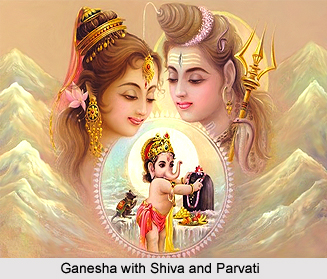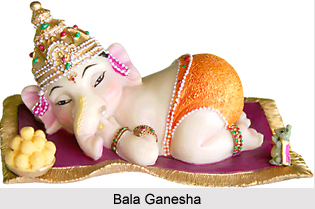 There are several different versions related to the birth of Lord Ganesha, the Remover of Obstacles and Lord of Beginnings, according to the Puranic traditions,. The elephant-headed Lord Ganesha, also known as Vinayaka, is considered as the deity of good fortune, new ventures and wisdom. He is also believed to be the Lord of letters and the destroyer of pride, selfishness and vanity. He is the son of Lord Shiva and Goddess Parvati. Some descriptions also mention that Ganesha was created by Parvati, by Shiva, by both Parvati and Lord Shiva or was found by Shiva and Parvati. Lord Kartikeya, also known as Murugan or Skanda, is generally considered as his elder brother in North India; while in southern India, Ganesha is regarded the first born son of Lord Shiva and Goddess Parvati.
There are several different versions related to the birth of Lord Ganesha, the Remover of Obstacles and Lord of Beginnings, according to the Puranic traditions,. The elephant-headed Lord Ganesha, also known as Vinayaka, is considered as the deity of good fortune, new ventures and wisdom. He is also believed to be the Lord of letters and the destroyer of pride, selfishness and vanity. He is the son of Lord Shiva and Goddess Parvati. Some descriptions also mention that Ganesha was created by Parvati, by Shiva, by both Parvati and Lord Shiva or was found by Shiva and Parvati. Lord Kartikeya, also known as Murugan or Skanda, is generally considered as his elder brother in North India; while in southern India, Ganesha is regarded the first born son of Lord Shiva and Goddess Parvati.
The various Puranas and ancient Hindu religious texts provide several versions about the birth and childhood of Lord Ganesha. These are mentioned below-
Shiva Purana
The most popular account of the birth of Lord Ganesha is provided in the Shiva Purana. Once, Goddess Parvati desired to take a bath, but there were no entourage to guard her and prevent others from entering accidentally. Thus the goddess formed a figure of a child out of turmeric paste that she used to wash her body. She gave life into the image and thus her son Ganesha was born. She ordered him to guard the entrance and he followed her orders obediently.
 Later when Lord Shiva attempted to enter, Lord Ganesha prevented him. Lord Shiva became infuriated and decapitated the child. Later when Goddess Parvati saw the death of her child, she became upset and angry. She demanded that her husband restore his life immediately. Upon the suggestion of Lord Brahma, Shiva sent the Ganas, his celestial army, to look for a living being lying with its head facing north. They found a dying elephant that lied in the specified manner and took its head after the elephant died. Shiva then attached the elephant head to the body of Ganesha and brought him back to life.
Later when Lord Shiva attempted to enter, Lord Ganesha prevented him. Lord Shiva became infuriated and decapitated the child. Later when Goddess Parvati saw the death of her child, she became upset and angry. She demanded that her husband restore his life immediately. Upon the suggestion of Lord Brahma, Shiva sent the Ganas, his celestial army, to look for a living being lying with its head facing north. They found a dying elephant that lied in the specified manner and took its head after the elephant died. Shiva then attached the elephant head to the body of Ganesha and brought him back to life.
Padma Purana
According to the Padma Purana, one of the main 18 Puranas, an aromatic oily paste was once applied all over the body of Goddess Parvati, which she removed during the time of taking a bath. The Goddess collected the fragrant paste removed from her divine body and a figure with the face of an elephant appeared out of it. Later Lord Shiva and Goddess Parvati put the figure into the River Ganga. The figure stretched out and gained life after it came in contact with the holy water of the Ganga. Eventually all the gods and deities gathered together and venerated him as Lord Ganesha, the remover of obstacles.
Linga Purana
In the Linga Purana, one of the major 18 Puranas, it is mentioned that after the gods and deities were frightened by the demons, they went to Lord Shiva to ask for help. They prayed to Shiva for the creation of a divine being who could hinder the movements of the demons and prevent them from terrifying the gods. Shiva assured them of help. Consequently, Lord Ganesha with an elephant head was born to Goddess Parvati. The noble child held a noose and a trident in his hands. All the gods and deities then appeared together to worship the divine child Ganesha. He eventually started to restrict the activities of the demons.
Brahmavaivarta Purana
According to the Brahmavaivarta Purana, after Goddess Parvati performed the Punyaka Vrata, which was suggested by the holy priest Sanat Kumara, she received Ganesha as a son. After completion of the Vrata, the priest demanded the payment or dakshina for performing the vrata. The Goddess gladly announced that she would grant him whatever he desired. Sanat Kumara then demanded his husband, Lord Siva, as the dakshina. This made Parvati extremely upset and she became unconscious.
All the gods and deities, including Lord Brahma and Lord Vishnu started to laugh. At the advice of all gods, Goddess Parvati honoured her word and gave away her husband and again became unconscious. After she gained consciousness, the Goddess offered Sanat Kumara the best of cows in return of Shiva. But the holy priest refused her generous offer. In her grief, Parvati worshipped Lord Krishna and desired to have a beautiful son like him. She was granted with a boon. Later all the gods persuaded Sanat Kumara to release Siva and he was freed from the bondage and returned to Goddess Parvati.
Later a Brahmin went the sacred abode of Parvati and begged for food. The deprived Brahmin fell at the feet of Shiva and Parvati and worshipped them. The old Brahmin asked for food from the vrata performed by Parvati and disappeared from the scene. The goddess looked all over for the Brahmin and discovered a baby on her bed. She lifted up the infant and embraced him. She adopted him as her son and organized a function and invited all the gods and goddesses to admire her son, Lord Ganesha.
All the gods went and blessed Ganesha except Lord Shani (Saturn). Lord Shani was reluctant to see his nephew but Parvati pleaded him to look at the child once. Lord Shani hesitantly cast his eyes on the baby and the head of Ganesha flew off. As soon as Shani Deva saw the noble child, the head of Ganesha was cut off. Lord Vishnu found an elephant and cut off its head to transplant on the neck of the child. Ganesha regained back his life and took the form of the elephant- headed god. Then all the deities declared the child to be the foremost of all the gods.
Several other similar accounts are also found in other religious scriptures that are related to the birth of Lord Ganesha.




















